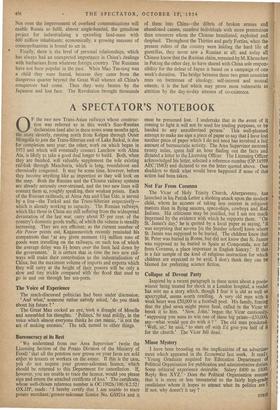A SPECTATOR'S NOTEBOOK
0 F the two new Trans-Asian railways whose construc- tion was referred to in this week's Sino-Russian declaration (and also in these notes some months ago), the more easterly, running north from Kalgan through Outer Mongolia to join the Trans-Siberian east of Lake Baikal, is duo for completion next year; the other, work on which began in 1953 and which will eventually connect Lanchow with Alma Ata, is likely to take a good deal longer to build. Both, when they are finished, will valuably supplement the sole existing rail-link through Manchuria, which is long, roundabout and chronically congested. It may be some time, however, before they become anything like as important as they will look on the map. Both the Russian and the Chinese railway systems are already seriously over-strained, and the two new lines will connect them at, roughly speaking, their weakest points. Each of the Russian railheads, at Alma Ata and Ulan Ude, is served by a line—the Turksil and the Trans-Siberian respectively— which is already working to capacity. The Russian railways, which like those in China are still suffering from the widespread devastation of the last war, carry about 85 per cent. of the country's domestic goods traffic, of which the volume is steadily increasing. They are not efficient; as the current number of Air Power points out, Kaganonovitch recently reminded his compatriots that ' at any given moment 11 i million tons of goods were travelling on the railways, on each ton of which the average delay was 81 hours over the limit laid down by the government.' It is certain that in time the two new rail- ways will make their contribution to the industrialisation of China; but the maximum volume of imports and exports which they will carry at the height of their powers will be only a slow and tiny trickle compared with the flood that used to go in and out through her sea-ports.


































 Previous page
Previous page